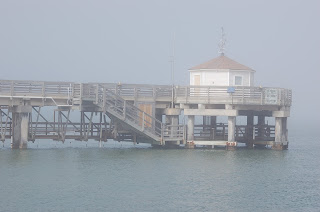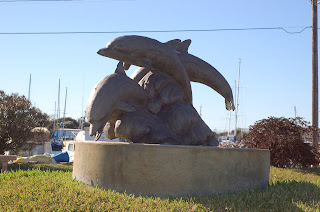Before I even visited Texas, I heard about Mustang Island. The person telling me about it spoke the name as if it was something special. It turns out it is. In an area where marshy areas dominate the landscape, the island offers a real beach. It has specific habitats. It hosts a variety of wildlife. It ..., well, let's let Texas explain:
“Mustang Island, Texas is an 18-mile-long barrier island located between Corpus Christi and the Gulf of Mexico. It features a continuous line of stable sand dunes. Dunes are created through the action of waves, tides, and wind-blown sand. Vegetation is critical to dune stability. It anchors the dune and catches wind-blown sand. Dunes act as a buffer against wave damage during storms. Barrier beaches, dunes, and vegetated barrier flats provide a unique habitat for a wide variety of pants and animals.”
Aransas Pass and Corpus Christi both claim parts of Mustang Island. The Aransas Pass end, the northern part of the island, has a variety of home styles, RV parks, a satellite campus of University of Texas that specializes in aquatic science, and a beach that you can drive on. The Corpus Christi end has a state park and a variety of vacation rental options near the beach. It also has a bridge.
The bridge is an important point, because Aransas Pass has no bridge. It has a state-operated ferry service. Four lanes of traffic drive onto one of several ferries and cross the narrow channel.
Signage at the UT …. Tells the story.
“The Aransas Pass Ship Channel serves two vital and harmonious roles for the Coastal Bend of South Texas. It enables water-borne commerce that is essential to the economy and exchange of water with the Gulf that is necessary for healthy bay. Water-borne commerce through this channel dates to the early 1800s. Today, it allows transportation of oil, petroleum products, offshore oil exploration equipment, dry/bulk cargo, and military transport to and from the Port of Corpus Christi. The Aransas Pass Ship Channel is the economic engine that drives much of the State’s economy.”
I saw all of the preceding on Mustang Island, as well as salt marshes, tourist attractions, restaurants, and outfitters. The outfitters were there to gear anglers and to keep dollars on the island. Costa sunglasses ranged from $100-250. Jackets from $70-170. I’m sure it was all good stuff, but I know people returned from Mexico with sunglasses they cheekily called “Fauxkleys” for $15 per pair.
My first trip to the island was just to get the feel of the place. I drove on the sand beach, explored a couple of RV parks, and looked at the architecture.
One of the most interesting places I stopped was a nature preserve. Decked walkways crossed wetlands and wide gravel paths wound through the area. They led to observation platforms that helped you get a sense for the landscape.
 |
| Marsh Grasses |
 |
| Development Beside the Wetlands |
 |
| Water Plants |
 |
| Fire Ants |
My second trip began eerily. There was a heavy fog that morning. During the ferry crossing, I could only see bright lights on the other side. All else was hidden. I found a 50% discount on golf cart rental and purchased a four-hour block. Driving down the beach in the cart was chilly and damp. Visibility was low and the wind was blowing. Fog condensed on the roof of the cart and dripped into my face as I drove.
I ventured toward the western side of the island where sun was burning through the clouds. It was warmer and safer. After lunch, I returned to the beach side and saw things I’d passed in the fog without even noticing they were there.
My third trip to the island brought home the reality of wind-blown sand. It was January 22 and Panama City, Florida was reporting gale-force winds and 6-9-foot waves in the Gulf. Can you guess where their wind comes from? It was still breezy here on the Texas Coast. So much so that a drive down the beach did not invite leaving the truck. Nor did the drive to the northern tip of the island to boat watch.
Wind blowing up the channel created whitecaps. Huge boats entering the channel hugged the inside of the lane, just in case. Oil tankers are not particularly aerodynamic and they wanted to give themselves room to be pushed around. Fine sand grains blasted the side of the truck and anything else in their path. Anybody outside was made miserable.
I went to the edge of the sand area, tucked between the seawall and sand dunes. As mentioned above, vegetation plays an important role in keeping the sand on the ground and protecting against the force of the wind. It was calm, sunny, and comfortable in that area.
 |
| On the mainland side of the Aransas Pass Ship Channel, oil platforms are brought in for maintenance. These two stand side-by-side and you don't appreciate their scale until you see a full-size pickup truck parked at the foot of one. |
 |
| A bridge crosses a pond at the UT educational complex. |
If you're from southern Indiana, it may seem like redwing blackbirds are everywhere during the summer. In particular, I see them in the tall grass that lines many rural roads. In the winter, they're gone. They fly south, like so many people's grandparents. I've wondered where they go. I can't speak for all of them, but quite a few were flying around one very windy day on the north end of Mustang Island.
These two were flying about with a murder (I looked that up — I thought it only pertained to crows). Here they have settled for a moment on the gate of a private pier belonging to a University of Texas educational facility.
It was a particularly blustery day. Over the Aransas Pass channel, pelicans were having a difficult time making any headway. Some gave up, settled in the choppy water and decided to paddle instead. Being lighter and more agile, these two and their murder made several aerobatic passes before settling. At one time more than a dozen clung to this barbed wire between brief flights over the area.







































